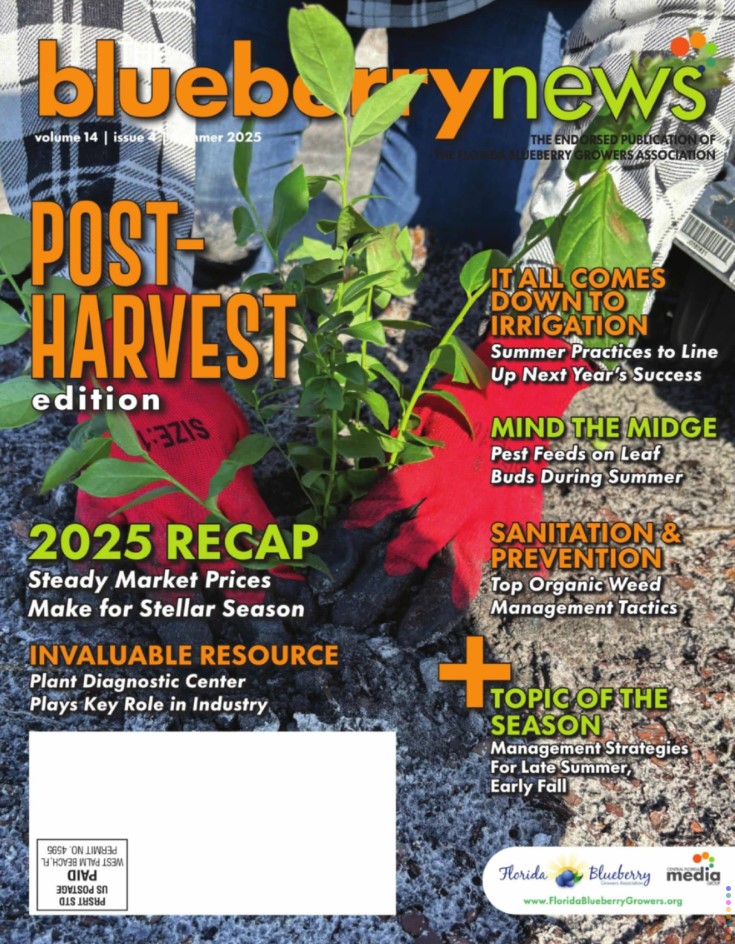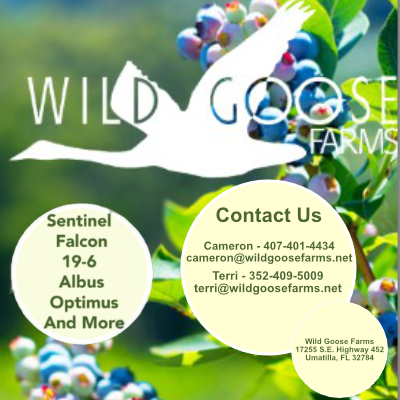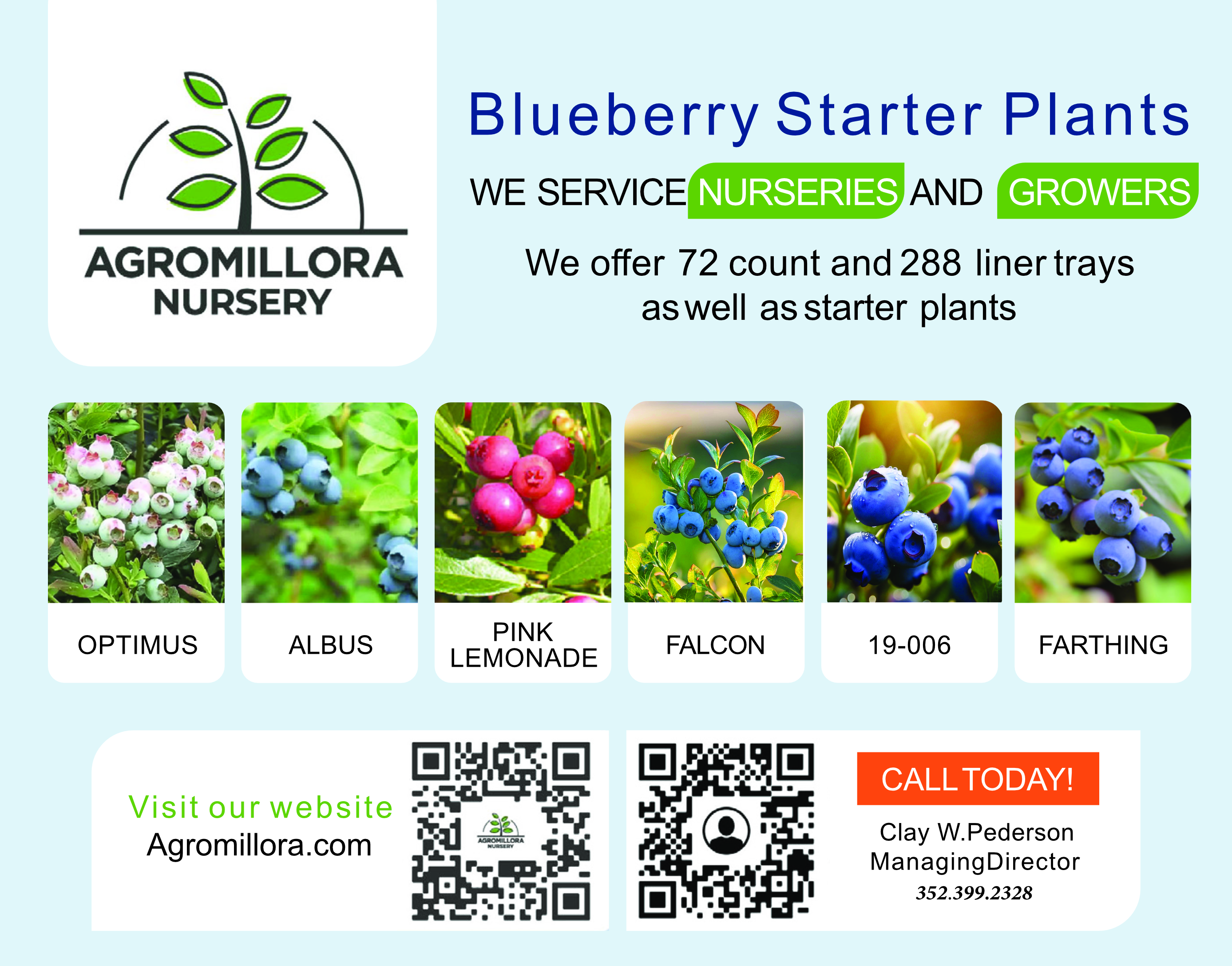Summer Fungal Leaf Disease Management
It’s complicated. Growers have many tools from which to choose when orchestrating their post-harvest plan to keep bushes healthy. These can range from horticultural inputs to selecting which and when to apply numerous fungicide product options. With blueberries in Florida, most consider the season to start at post-harvest hedging and end the following calendar year with a successful harvest of fruit. Hedging (pruning away the old canes) resets the plants to produce a flush of young canes and new leaves. Leaves hang around until winter in deciduous production, and through the next harvest in evergreen. That’s a long time to keep leaves healthy. When things go wrong and bushes are severely defoliated prior to these times, flower bud initiation and carbohydrate storage (sugars used by the plant to push the blossoms, fruit, and new growth) suffers, reducing the harvest. The flip side is that management tools cost money and without knowing the return on investment, how clean can you afford to grow? The answer depends on many factors from the price you see during your harvest, the varieties in your fields, to how many tropical weather systems buzz overhead each summer. As a grower once told me … I know keeping leaves healthy is important, but they don’t eat (or sell) too good!
In general, summer in Florida brings hot and humid weather, along with increased rainfall and ideal conditions for the development of summer fungal leaf diseases. There are several of these diseases that develop symptoms that can look similar and even occur on the same leaves. This article will discuss the different types of fungal leaf diseases we typically see in Florida, including a discussion of symptoms and some management suggestions. Additional information can be found in the UF/IFAS Blueberry Growers Guide app, and EDIS Publication PP348, Florida Blueberry Leaf Disease Guide (https://edis.ifas.ufl.edu/publication/PP348).
Anthracnose Leaf Spot
Anthracnose leaf spot is caused by Colletotrichum gloeosporioides and can result in premature defoliation, poor floral bud development, and subsequent loss of yield. Symptoms are irregularly shaped lesions at the leaf edges, expanding from 1/4 inch to greater than 3/4 inch in diameter. The lesions have necrotic centers ranging from brown to dark brown, with distinct concentric circles (bull’s-eye patterns) occasionally visible (Figure 1). The fungus overwinters in infected leaves and stems from the previous season. In spring, when the weather gets warmer and more humid, the fungus produces spores that are spread by splashing water (rain or overhead irrigation), workers, and equipment. These spores will germinate and initiate new infection cycles. Anthracnose leaf disease is common after harvest in Florida and persists through summer. In evergreen systems, this disease can be present on foliage throughout the winter months and harvest and can provide a source of inoculum for anthracnose fruit rot. Blueberry cultivars differ in their susceptibility; “Jewel” is considered very susceptible.
Figure 1. Anthracnose leaf spot symptoms
Credits: P. Harmon, UF
Management
Many registered fungicides are labeled for anthracnose on blueberry in Florida, and applications work best before symptoms become significant. On susceptible cultivars, applications should begin after post-harvest pruning, with reapplications according to label instructions through September in the deciduous production system. Demethylation inhibitor (DMI) fungicides (FRAC 3) such as IndarTM, OrbitTM, QuashTM, Quilt XcelTM, and ProlineTM are options to be used in rotation or in tank mixtures with compatible products from another group to help prevent fungicide resistance. Fungicides with different modes of action such as Luna TranquilityTM (FRAC 7 & 9), AboundTM (FRAC 11), PristineTM (FRAC 11 & 7), SwitchTM (FRAC 9 & 12), and captan (FRAC M4) are suitable for rotation with DMI fungicides. Single applications of BravoTM (FRAC M5) are also recommended after harvest. Anthracnose resistance to AboundTM and other FRAC group 11 fungicides has been confirmed in Central Florida, so these should be used in a premix product with two active ingredients or tank-mixed with another fungicide like captan to ensure efficacy. Fungicides with mono- and dipotassium salts of phosphorous acid have systemic action and include Agri-FosTM, K-PhiteTM, and ProPhytTM (potassium phosphite). These “phites” have shown some effectiveness against anthracnose. In evergreen systems, fungicide applications should continue from late fall through harvest, within applicable label limitations and rules.
Phyllosticta
Phyllosticta leaf spot is caused by Phyllosticta vaccinii, and is more commonly observed later in the summer (August–September) than anthracnose. Symptoms are brown leaf spots with irregular borders. Lesions range from small (less than 1/4 inch) to larger than one inch prior to causing defoliation. Lesions typically are surrounded by a dark brown to purple margin. A distinguishing feature of this disease is the presence of tiny black fungal pimples (pycnidia, the reproductive structures) that develop within the lesions (Figure 2). However, other fungi, including some that do not cause disease, can also produce small black structures on dead or decaying leaves. This disease is common in Florida, but it is considered to be of minor importance.
Figure 2. Phyllosticta leaf spot symptoms
Credits: P. Harmon, UF
Management
There are no published fungicide recommendations for Phyllosticta leaf spot management on blueberry in Florida; however, in other crops (e.g., cranberry and maple), related diseases are managed with applications of the contact fungicide BravoTM (FRAC M5). General maintenance applications of contact fungicides like BravoTM or captan are recommended after harvest as needed or approximately every two weeks (for up to 6 weeks).
Rust
In Florida, this disease is caused by Naohidemyces vaccinii. Infected bushes can show premature defoliation, a decrease in floral bud differentiation, and reduced yield. Different levels of susceptibility to this disease can be found in southern highbush blueberry (SHB). Symptoms are typically first observed on the upper leaf surface and begin as small, somewhat angular yellow spots that turn reddish-brown to black over time. Multiple black-to-red lesions can occur on the same leaf, ultimately turning the leaves yellow and red (Figure 3) before causing defoliation. Brightly colored yellow to orange spores are produced on the underside of the leaf, opposite the lesions on the upper leaf surface, and are key to distinguishing this disease from other leaf spots (Figure 4).
Figure 3. Rust symptoms on leaf top Figure 4. Rust spores on leaf underside
Credits: P. Harmon, UF Credits: P. Harmon, UF
Rust spores are spread efficiently by wind. New leaf infections can begin in spring during or just after harvest, and disease activity increases again in early fall. In evergreen production the pathogen can persist throughout winter and harvest, causing fruit infections and defoliation which limits plant photosynthesis to support fruit development.
Management
Applications offungicides are the best method of control. Systemic fungicides can move into the infected leaves and potentially stop rust development. However, most products will only reduce or delay the amount of sporulation because fungicides do not effectively kill the fungus inside the leaf. Fungicides do a better job of protecting against new infections, so making repeated applications to maintain a protective residue on the leaves is key to preventing the disease. Fungicides such as OrbitTM, IndarTM, QuashTM, ProlineTM (FRAC 3), PristineTM (FRAC 11 & 7) and BravoTM (FRAC M5) are effective against rust. Applications should begin after harvest and continue through late October on susceptible cultivars. In evergreen systems, fungicide applications should continue from late fall through harvest, within applicable label limitations and instructions. Fungicides with different modes of action should be used in rotation or in a tank mix and as part of an integrated post-harvest foliage management strategy.
Septoria
Septoria leaf spot is caused by Septoria albopunctata. Severe infections can decrease yield due to defoliation, reduced levels of photosynthesis, and reduced flower bud initiation. Septoria spots are numerous but small (about 1/8 inch) and nearly circular, with light-brown to gray centers and broad purplish margins (Figure 5). These lesions can coalesce into larger necrotic areas prior to defoliation. Symptoms are generally more severe on older leaves that are closer to the ground. The disease typically occurs from mid to late harvest through June and may reappear during mild wet periods in fall. The pathogen can overwinter in infected or dead leaves and stems, or on other plant hosts, with spore germination and infection favored by mild wet weather (75°F–82°F). Early lesions serve as an inoculum source for further disease development, with spores spread by water splash (rain and overhead irrigation).
Figure 5. Septoria leaf spot symptoms
Credits: P. Harmon, UF
Management
Applications of protective and systemic fungicides with different modes of action help to reduce Septoria leaf spot severity. Fungicides of FRAC group 3, such as OrbitTM, IndarTM, QuashTM, Quilt XcelTM and Proline, and fungicides of other FRAC groups, such as Luna Tranquility (FRAC 7 & 9), AboundTM (FRAC 11), SwitchTM (FRAC 9 & 12), PristineTM (FRAC 11 & 7), and BravoTM (FRAC M5), are effective against this disease. Systemic phosphite fungicides such as Agri-FosTM, ProPhytTM and similar phosphonate products are also effective against Septoria; however, they must be applied after harvest to avoid possible fruit damage.
Target Spot
Target spot is caused by Corynespora cassiicola, first reported in blueberry in the US in 2014. More recently it has become a significant disease for Florida growers with significant defoliation observed on many SHB cultivars. Typical symptoms are 1/3- to 3/8-inch angular to irregular reddish-brown lesions with colors varying in concentric rings, resulting in a “target” or bull’s-eye pattern (Figures 6 and 7). Symptoms can be similar to the early symptoms of anthracnose leaf spot, and both diseases can occur simultaneously in susceptible varieties. However, target spot lesions tend to remain smaller, whereas anthracnose leaf spots can increase to larger than 1/2 inch in diameter. Fewer target spot lesions are required before defoliation begins compared to anthracnose. Environmental conditions such as humid weather, warm temperatures (79°F–84°F), and moderate rainfall favor abundant fungal sporulation and rapid disease development. In the field, spores can be spread by wind or water splash (rain or irrigation).
Figure 6. Target spot symptoms Figure 7. Target spot symptoms
Credits: P. Harmon, UF Credits: D. Phillips, UF
Management
Growers have reported difficulty managing target spot once symptoms are observed and become significant. Preventive fungicide applications where the disease is known to occur and/or careful scouting for the first disease symptoms are encouraged. Limiting periods of leaf wetness and high humidity within the plant canopy may also help reduce disease severity, accomplished by avoiding overhead irrigation, maintenance pruning to open canopies, and managing weeds in beds and row middles to increase airflow. No fungicide resistance is known at this time, and most fungicides that are used to manage anthracnose and rust should be effective against target spot. Growers should ensure good, even coverage with spray equipment to increase the efficacy of the fungicides applied.
In summary, these leaf diseases include some of the most common and problematic to occur on southern highbush blueberry in Florida, but there are others less frequently encountered. Growers are encouraged to submit a sample to a UF/IFAS Plant Diagnostic Lab to determine what diseases may be active on their foliage during particularly difficult outbreaks or if symptoms do not match those pictured in extension resources. In planning a fungicide schedule or program, growers will note that several fungicide products are listed above that can help manage multiple diseases in the post-harvest period. In addition to those listed above, applications of fungicides that contain various forms of copper have some efficacy on these leaf diseases when applied during the summer for the management of algal stem blotch. Some copper fungicides are also approved for organic production and represent the most consistent performers for reducing disease pressure for organic growers. Current ongoing research is also evaluating some plant-derived oil products that are available for organic producers for their potential efficacy as well.
For conventional growers, the multisite contact fungicide Bravo (which cannot be used preharvest) is excellent for preventative applications during the post-harvest time frame to supplement the copper schedule or at the first symptoms of breakthrough leaf diseases, particularly on varieties or farms that have suffered from them in past seasons. More expensive, but potentially more effective, systemic fungicides can be applied at the same time (tank mix) or as alternatives to Bravo where unacceptable results occur otherwise. Be mindful of seasonal limits on the max number of applications that can be made and consider preserving products like Switch for those important bloom-through-harvest applications that can help us prevent fruit rots. In the end, growers have tough decisions to make regarding post-harvest leaf disease management each year, with their experiences from previous years informing estimations of risk and weighing potential returns on the investments of the many options available.
Credits:
Philip Harmon, Professor, Plant Pathology, University of Florida& Doug Phillips, Blueberry Extension Coordinator, University of Florida





